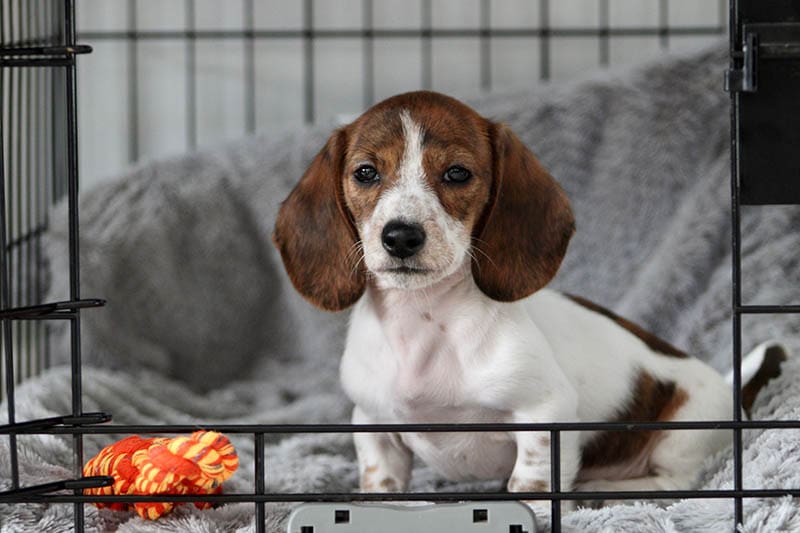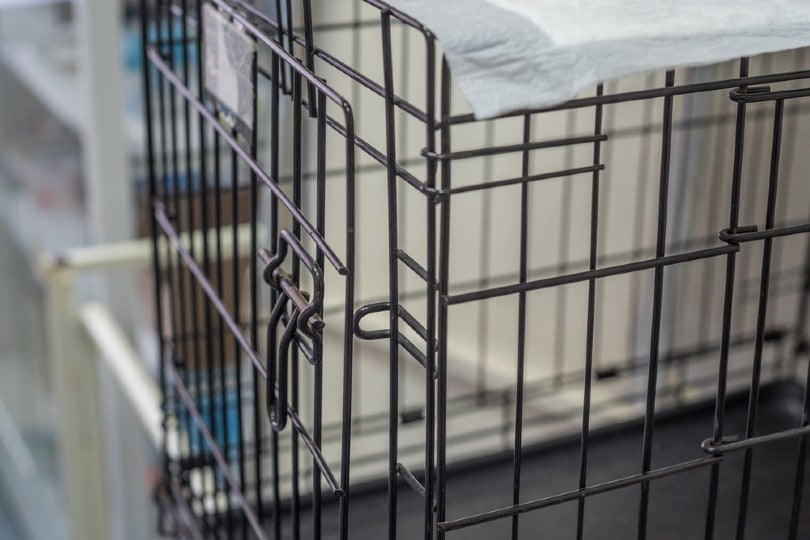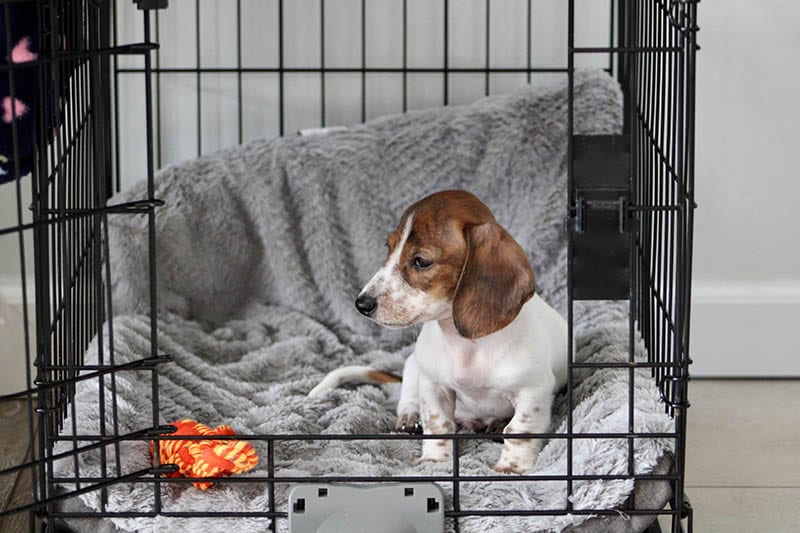How to Crate Train a Dachshund in 9 Easy Vet-Reviewed Steps
By Kit Copson
Updated on

Dog crates are indoor kennels that provide a safe, comfortable space that your Dachshund can retreat to and enjoy relaxing in. When used as recommended, you and your Dachshund can reap several benefits from having a crate as they get dogs used to spending time alone, help with toilet training, help dogs feel less stressed if they ever need to go to the vet or travel in a crate, and sometimes aid in recovery from certain injuries or illnesses.
Your Dachshund’s crate should always be a place they feel secure in—it should never be used to punish them as this will lead to your Dachshund associating their crate (and you) with something negative. This damages the bond between you and your Dachshund, so crate training and use should always have positive connotations for your Dachshund.
If you’re not sure where to start with crate training, below is a step-by-step guide on how to train your Dachshund to use a crate in nine simple steps. We hope you find it useful!
How to Crate Train a Dachshund
- A suitably sized crate
- Treats
- Toys
- Dog bed or padded mat
- Blanket
1. Choose the Right Size Crate
If your dog is a Dachshund, a gigantic crate just won’t do. Furthermore, too large crates encourage dogs to go to the bathroom on one side of it because there’s plenty of room to do so. Likewise, you don’t want to get something that’s too cramped. What you’ll need is a crate that will be big enough for your puppy or dog to stand up in, turn around, and lie down without issue.
It’s a good idea to imagine what size your Dachshund will be as an adult and buy a crate that they’ll comfortably fit into. If it’s too big for your puppy, you can always use crate dividers to reduce its size for the time being.

2. Position the Crate
Choose where you want to position the crate, a quiet and calm space is usually best. Your living room, home office or bedroom are great options, but it can be anywhere you spend a lot of time calmly. This is important because it may help your Dachshund to feel more secure knowing they’re close to you. For this reason, putting the crate in or close to your bedroom is a good idea, especially for puppies. The crate in time will become a peaceful haven for your pup to retreat to when they want some quiet time or a nap.
3. Kit Out the Crate
Your Dachshund isn’t going to enjoy spending time in a barren crate with nothing fun inside. Kit the crate out with a comfortable dog bed or mat and a soft blanket with your scent on. Put your Dachshund’s favorite toys inside—a chew toy is a great idea.

4. Introduce Your Dachshund to the Crate
Lead your Dachshund to the crate and encourage them with a relaxed but upbeat tone. Place a few of your dog’s favorite treats inside by the door of the crate and wait for them to go inside.
Gradually add more treats, moving them further into the crate each time until your Dachshund feels comfortable going all the way inside. If your Dachshund isn’t treat-motivated, try their favorite toy instead. Don’t close the door on your Dachshund at this stage.
Never force your Dachshund inside if they don’t want to go—some Dachshunds may take to crate training very quickly whereas others need a bit more time. Be consistent and encouraging and you’ll soon start to see progress.
5. Feed Your Dachshund in the Crate
Once your Dachshund is confident enough to go in the crate by themselves, place their food bowl inside at the rear end of the crate and allow them to go in and eat there. For dogs who aren’t confident yet, start by putting the food bowl by the crate door and, as with the treats, move it further into the crate each time you feed them. Feeding every meal in there will quickly help them associate the crate with a prized resource.

6. Shut the Door
When your Dachshund feels comfortable eating their dinner in the crate, you can start closing the door when they start eating. Open it up again when they’ve finished so they get used to the crate being closed gradually. Gradually increase the amount of time you leave the crate door closed.
If your Dachshund howls or whines to be let out, wait until they stop before opening the door. If they learn that whining will get them out, they’ll continue to do this in the future.
7. Teach a “Crate” Command
Take a treat and make sure your Dachshund can see it. Once they go inside immediately say “crate”, give them the treat and plenty of praise. Consistent practice will soon have your dog connecting the word and the place crate. In the future, your Dachshund should be able to go in the crate at this command without being offered a treat.

8. Get Your Dachshund Used to Spending More Time in the Crate
At first, your Dachshund should only spend a short time in the crate while they’re getting used to it. Then, you can gradually start leaving them inside for longer until they reach at least 30 minutes of being at ease in the crate. At this point, you can try leaving the house for a short period while your Dachshund is in the crate.
9. Have Your Dachshund Spend a Night in the Crate
Puppies are likely to need a bathroom break at some point in the night, so make sure the crate is positioned near enough so you can hear them if they start to make noise.
Make sure your Dachshund puppy goes to the bathroom before bedtime to try and reduce the number of times they need to go during the night. Take them out to pee first thing in the morning, too.

Final Thoughts
It’s unrealistic to expect crate training to happen straight away. Different dogs require different lengths of time to learn, with some needing up to six months of consistent crate training.
To reiterate, never use the crate as a punishment or to “imprison” your Dachshund. Instead, teach them to associate the crate with enjoyment, comfort, and security. By following the above steps and with a bit of perseverance, you’ll get your Dachshund loving their crate in no time
Featured Image Credit: Vernace, Shutterstock













